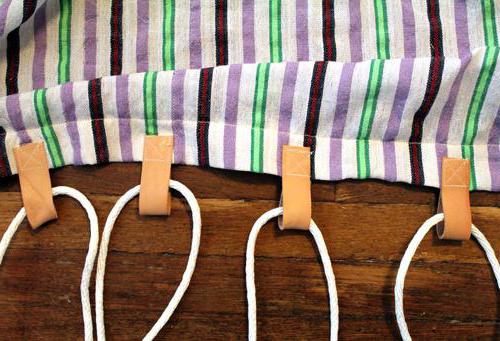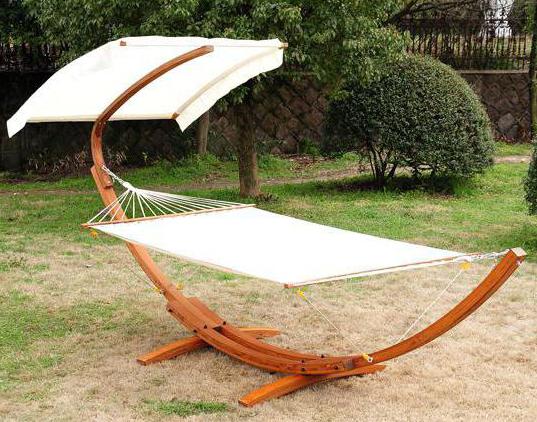For outdoor recreation, people choose the most beautiful places. But lying on the grass under the scorching rays of the sun, a person experiences discomfort. In order to enjoy communication with nature, people invented a hammock with a frame and a canopy. What it happens, and how to make it with your own hands, read the article.
A bit of history
The hammock was invented by Indians from South America. It was used for daytime rest and overnight. The hammock served as a reliable protection against insects and dampness. Later it was appreciated by sailors from Spain. They slept in uncomfortable bunks, and therefore replaced them with hammocks.
Hanging beds were then cheap, and whoever had absolutely no money to buy them, sewed themselves. In Europe, hammocks are not appreciated. They did not become a bed for sleeping. A hammock with a frame and a canopy was used for a short rest.
Choose a hammock to relax in the country
To make the hammock convenient and comfortable, you need to choose it correctly. Attention should be paid to the following:
- A hammock for a summer residence with a frame and a canopy should be spacious and stable, so that when tilted at a slight angle, a person does not fall out of it.
- It is necessary to check the reliability of the design. Particular attention should be paid to the crossbars. They hold the fabric in a taut position and prevent it from sagging to the ground. Therefore, they must be very durable. Usually a hammock can support two hundred kilograms of weight.
- The fabric needs to choose a strong, breathable and non-irritating skin. Soft and elastic cotton or tough and strong nylon are best for a hammock.
How to sew a hammock on your own?
For this you will need: a piece of fabric made from natural fibers, a sewing machine, threads, scissors, a belt or thick tape, ropes made of durable material. When everything you need is cooked, you can get to work.
- To do this, the fabric is laid out and the desired section is measured: one meter wide and two meters long. Each side of the fabric is tucked about a centimeter and hemmed.
- Next, take a belt or canvas tape five centimeters wide. The short side of the fabric is tucked to this width. The tape is inserted inside and it all grinds down. The same should be done with another short edge.
- Strips of fifteen and three centimeters wide are cut from very dense tissue or pieces of skin. A total of eighteen pieces are needed.
- The strips are folded in half (a loop is obtained) and sewn onto the short sides of the cloth, so marks are made on the fabric in advance, the distance between which should be the same.

- Next, 18 pieces of strong rope are cut, each two meters in length. They are threaded through leather loops.
- Then all the ropes are joined together and one big loop is made. She is tied with a knot and is wrapped first with the same rope, and then with high-strength cotton thread. The same thing is done from the second short edge of the banner.
Landing
Now you need to install a hammock with a frame and a canopy with your own hands. It can be hung between the trees. If there are no natural supports nearby, they must be made of metal or wooden posts themselves, which are installed taking into account the length of the panel. Pillars are placed in pits to a depth of not less than a meter. For reliability, the recesses are poured with a cement solution. When it hardens, a hammock with a frame and a canopy is installed.
As a roof, use a waterproof sunscreen fabric. The dimensions of the canopy coincide with the distance between the supports. The roof is installed above the sunbed. The principle of fastening is the same, only you need to pull it with more force so that there is no sagging. For a canopy, a large umbrella, which can be bought in a store, is suitable. It is attached to one of the racks.
DIY hammock frame
If you independently make and install a hammock with a frame and a canopy in the country, family reviews will be only positive. Adults and children will enjoy relaxing while lying on a hanging bed. But first you need to stock up on materials and tools. Here's what you need to make the frame:
- Two bars of a meter and a half meter length of the same cross section. Those that are shorter are needed for mowing, and more truly for racks.
- A pair of bars of two meter length and four one meter for the crossbars.
- Threaded radial hooks. Two pieces are enough.
- Galvanized wood screws.
- A pair of bolts.
- Screwdriver, wrench for nuts.
- Enamel or stain for coating wooden surfaces.
Getting to the construction of the frame. To begin, the crossbars should be attached to the racks. Then one hook is screwed into each. The height from the end of the rack is 1.2 meters. To facilitate your work, you can pre-drill holes in the mounting location. Two-meter bars are attached to the ends with attached cross members parallel to each other. The ends of the bars one meter long are sawn off at an angle of 45 degrees. The bars in the saw area are drilled through and fastened with a vertical stand. These will be the extreme crossbars.
The jibs are attached on one side to the uprights, and on the other to longitudinal, parallel bars. In these places, one more transverse bar is installed. An umbrella mount is mounted on one rack. It is very simple. Two metal strips are cut out and attached to the inside of one of the supports. The hammock frame is ready.
General rules
A hammock with a frame and a canopy, the photo of which you see, is of different models, but the requirements are the same for everyone.

- Supports and fixtures must be reliable. The hammock is hung in different ways. It can be placed between trees with a trunk diameter of twenty centimeters or more. You can use poles or supports from the swing. In this case, they need to be dug into the ground.
- A hammock with a frame and a canopy is suspended a meter and a half above ground level. Supports are installed at a distance of two to three meters from each other. If they are buried, the distance is calculated as follows: thirty centimeters are added to the length of the hammock.
- To fasten the hammock, the ropes must be strong and thick. For reliability, the fabric is reinforced with eyelets.
- For a hammock, it is recommended to use a mattress, tarpaulin or camouflage fabric. Note: synthetic fiber fabrics are cheap, durable and lightweight, but not hygroscopic. The body will not breathe. It’s better not to be stingy and get a natural fabric that passes air well and does not irritate the skin. In addition, it quickly takes the desired shape.
- Cords, if their use is necessary for this model, it is better to choose cotton. Knots are tightened on them, and touching them is more pleasant. Clamps are put on the places of contact of the cord with a tree or a support. Nylon tubes are suitable for their manufacture.